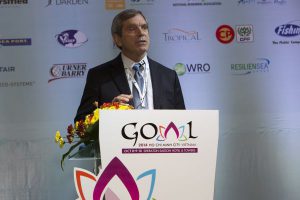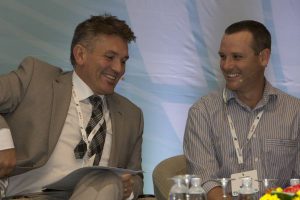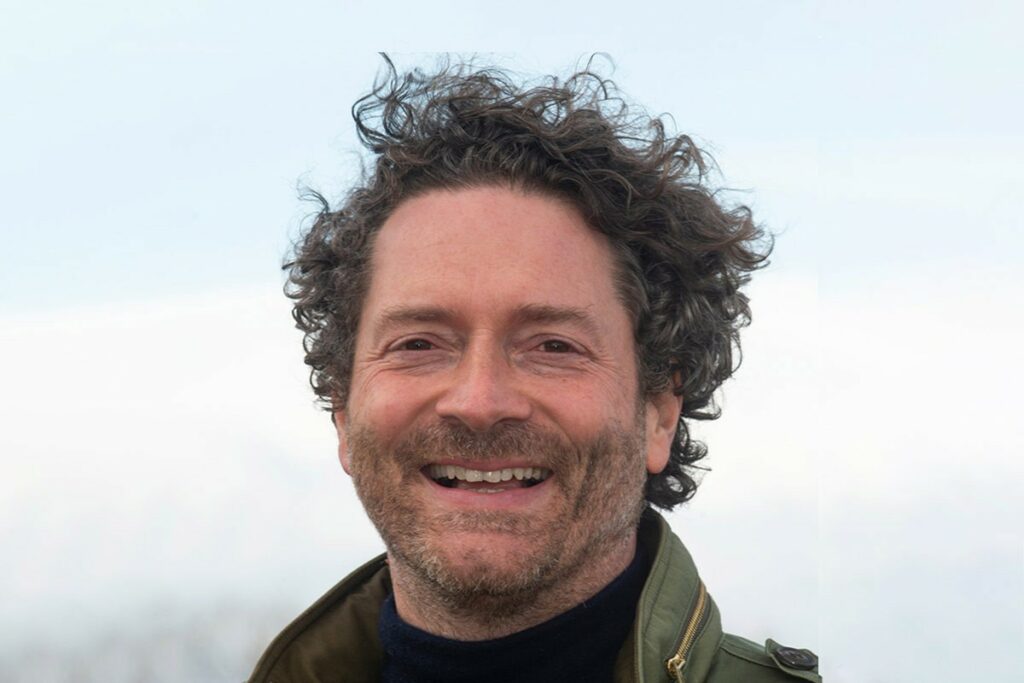GOAL 2014 Roundup: ‘Battle Against EMS Is Shifting’
The tide is turning on early mortality syndrome (EMS). That’s the No. 1 takeaway from the Day 1 program at the Global Aquaculture Alliance’s GOAL 2014 conference in Ho Chi Minh City, Vietnam.
 On Oct. 8, GAA President George Chamberlain (pictured at right) lead a panel on health and disease management featuring Tim Flegel of the Thai National Science and Technology Development Agency, Loc Tran of Minh Phu Aquamekong ShrimpVet Lab at Vietnam’s Nong Lam University, Peter Marshall of R.S. Standards and Brendan Cowled of AusVet Animal Health Services.
On Oct. 8, GAA President George Chamberlain (pictured at right) lead a panel on health and disease management featuring Tim Flegel of the Thai National Science and Technology Development Agency, Loc Tran of Minh Phu Aquamekong ShrimpVet Lab at Vietnam’s Nong Lam University, Peter Marshall of R.S. Standards and Brendan Cowled of AusVet Animal Health Services.
In his 30-minute presentation on EMS, Chamberlain was the bearer of good news and bad news. First, the bad news. In the wake of EMS, new diseases are already appearing in shrimp in Asia — microsporidean parasites and a new nodavirus called covert mortality nodavirus.
Now, the good news. “The battle against EMS is shifting from guessing what to do to implementing what works,” said Chamberlain. There is no “silver bullet,” a single cure or disease prevention method, he explained. But global shrimp production is set to rebound thanks to a combination of better diagnostics and breeding, in addition to better practices at the farm, hatchery and feed-production levels.
Shrimp production will not grow without comprehensive disease management protocols, said Chamberlain. But these protocols are beginning to be employed. For example, deeper ponds with high yields—like the ones used in Pangasius farming in Vietnam—are being used in shrimp farming in China. Additionally, the industry is working more collaboratively that it ever has.
 The preliminary results of GAA’s EMS survey are in. Cowled (pictured at left with Marshall) analyzed the preliminary results on behalf of GAA. There were 1,351 survey respondents, thanks mainly to Grobest Group, which urged its salespeople in the field to urge its farmers to participate. An encouraging trend is occurring in Mexico, said Cowled. “Resistant shrimp may be proactive,” he said.
The preliminary results of GAA’s EMS survey are in. Cowled (pictured at left with Marshall) analyzed the preliminary results on behalf of GAA. There were 1,351 survey respondents, thanks mainly to Grobest Group, which urged its salespeople in the field to urge its farmers to participate. An encouraging trend is occurring in Mexico, said Cowled. “Resistant shrimp may be proactive,” he said.
Interestingly, the audience was asked, via the conference’s automatic response system, “What’s the No. 1 tool for managing EMS?” Farm management topped to the poll at 37 percent, followed by genetic resistance at 30 percent, hatchery management at 18 percent, diagnostics at 13 percent and feed additives at 3 percent.
The next step, said Chamberlain, is zone management, which is key to effective disease management. Zone management has multiple advantages, particularly the ability to control proximity among farms and to stay within carrying capacity of receiving water body. GAA has established a Zone Management Technical Committee to initiate the process of drafting Best Aquaculture Practices (BAP) certification standards for zone management, potentially acting as a fifth BAP star.
Zone management coupled with improvements in technology will enable global shrimp production to overcome EMS and double in a decade, predicted Chamberlain. That would take shrimp production to around 8 million metric tons.
 In his 45-minute presentation following the panel on health and disease management, the World Bank’s Jim Anderson laid out just how impactful EMS has been on global shrimp production, which he called a “multi-billion dollar problem.”
In his 45-minute presentation following the panel on health and disease management, the World Bank’s Jim Anderson laid out just how impactful EMS has been on global shrimp production, which he called a “multi-billion dollar problem.”
Anderson presented a graph that illustrated where shrimp production would have been by 2016, if EMS had not existed and growth had continued at the average annual rate of 4.4 percent between 2006 and 2012.
Instead, production dropped 19 percent in 2013, and shrimp production is projected to total around 4 million metric tons in 2016. It would have totaled close to 4.5 million tons had EMS not existed.




